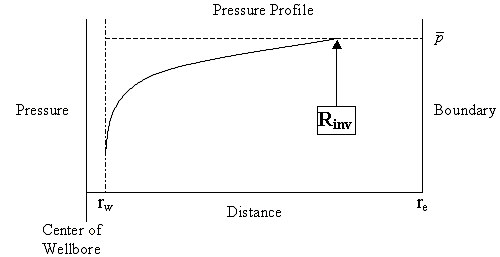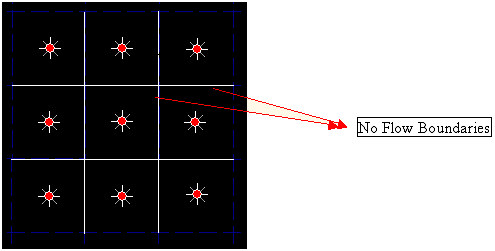Radius of Investigation (rinv)
Subtopics:
Related Topic:
Displaying Radius of Investigation
Radius of investigation represents the distance that transient effects have traveled into the reservoir.
A pressure transient is created when a disturbance such as a change in rate occurs at a well. As time progresses, the pressure transient advances further and further into the reservoir. This concept is not theoretically rigorous, but is adequate for practical purposes. Theoretically, when a pressure disturbance is initiated at the well, it has an immediate effect, however minimal, at all points in the reservoir. At a certain distance from the well, however, the effect of the disturbance are so small as to be unmeasurable. The furthest distance at which the effect is detectable is called the radius of investigation, rinv.
The figure below illustrates the basic concept of radius of investigation using a plot of pressure versus distance into the reservoir.

The radius of investigation is calculated using the following equation:
| Note: | The constant 948 is one of many that appear in the literature, and in general provides a good approximation. |
Notice that the radius of investigation is only a function of the reservoir properties, and does not depend on flow rate. Increasing the flow rate results in a greater drawdown (p - pwf), but the radius of investigation is the same.
In order for heterogeneity to be identified, the radius of investigation of a test must be greater than or equal to the distance to that heterogeneity.
The examples below illustrate how radius of investigation can be used. For information on displaying the radius of investigation in the software, see Displaying Radius of Investigation.
Estimating Drainage Area
When analyzing a pressure transient test, radius of investigation can be used to estimate drainage area as follows:
This represents the minimum drainage area before boundary effects are observed. This same application can be applied to estimate distances to reservoir heterogeneities.
Estimating Shut-in Duration
The radius of investigation concept can also be used to estimate the required duration of a shut-in for a buildup test. For example, in the middle of a reservoir that has evenly spaced wells producing at about the same rate, no-flow boundaries develop between producing wells as shown below:

In this situation, the drainage area of a well is defined by the no- flow boundaries. Using this area, you could estimate the time it would take to reach the boundaries of the drainage area by rearranging the radius of investigation equation as follows:
References
"Theory and Practice of the Testing of Gas Wells, Third Edition", Energy Resources Conservation Board (ERCB), pp. 3-34 to 3-36, 1975.